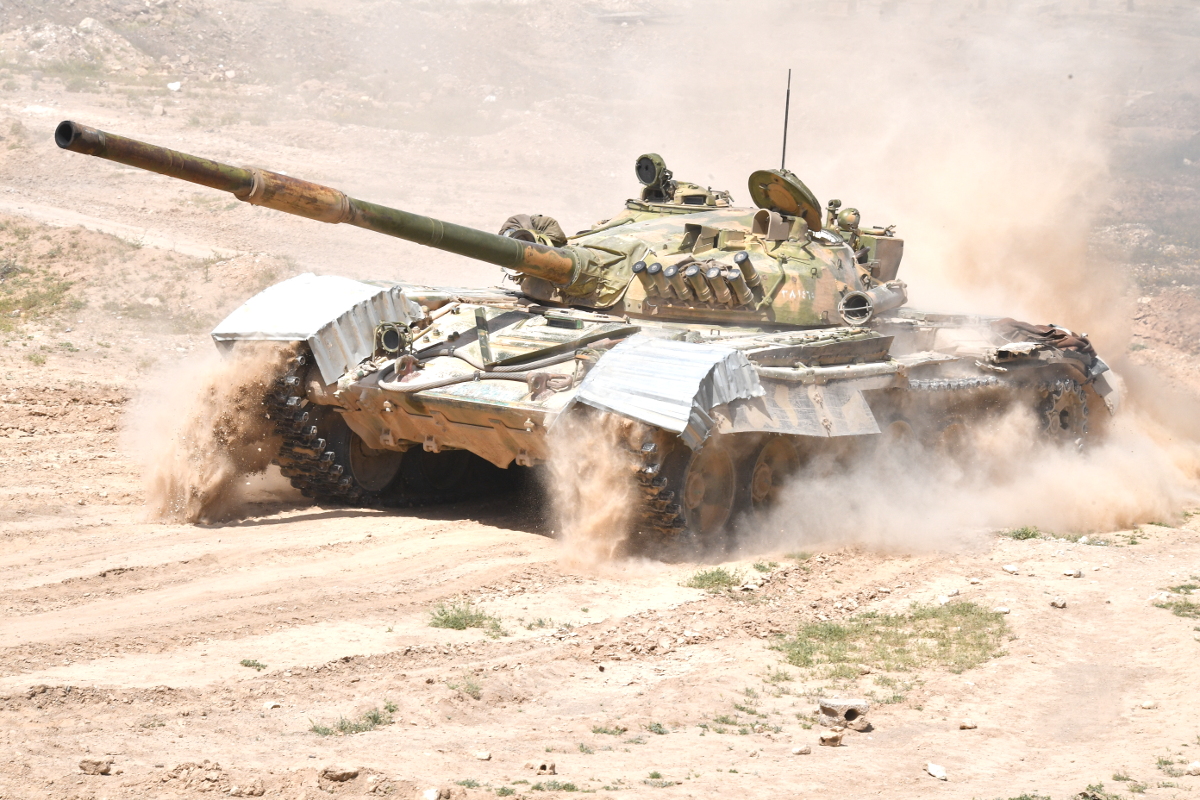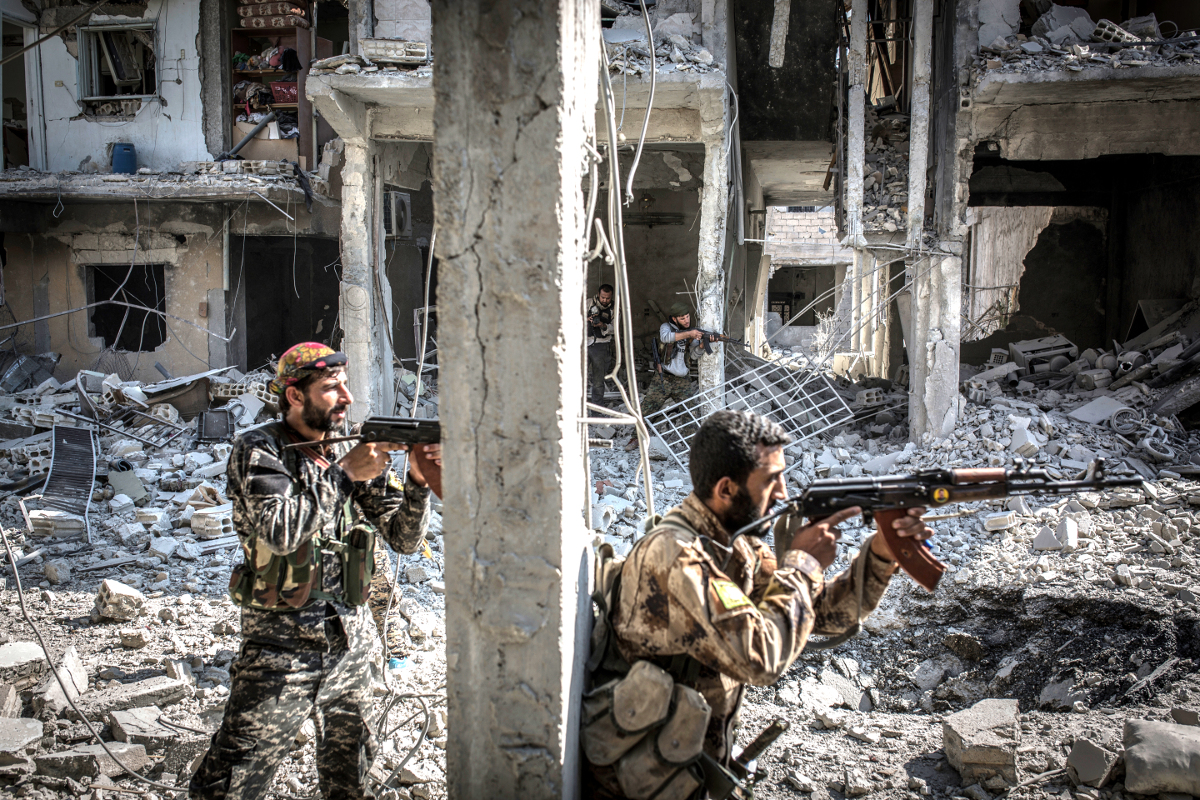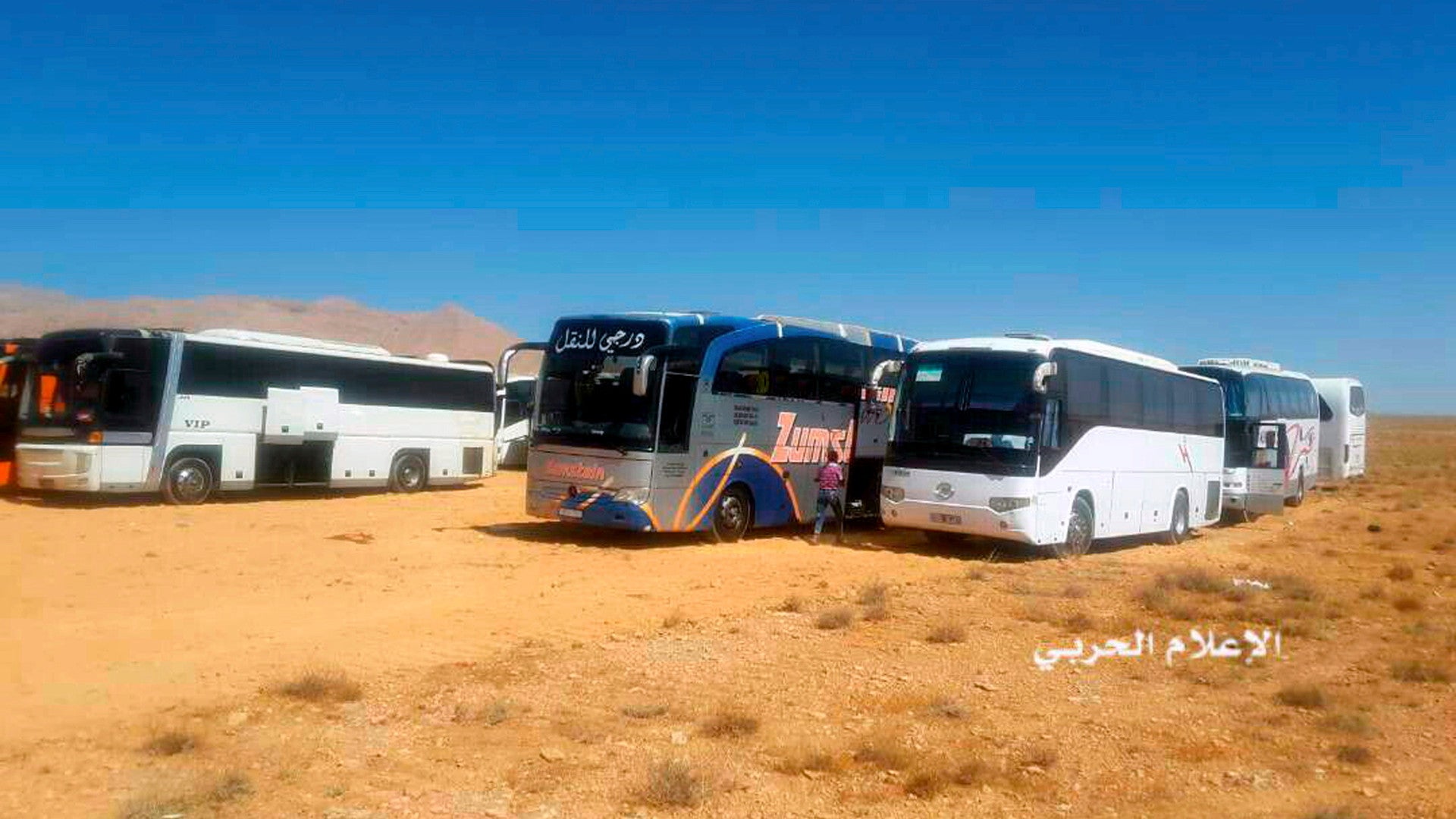Tensions in southern Syria have flared following an agreement between Iranian-backed Lebanese Hezbollah militants and ISIS that sent air-conditioned bus loads of the terrorists and their families east toward the Iraqi border. The deal has sparked anger in Iraq and with its U.S.-led coalition allies, who launched air strikes to block its progress, but not destroy it directly.
On Aug. 28, 2017, approximately 300 ISIS members and an equal number of family members, including young children, began to depart their camps in the Qalamoun Mountains near the Lebanon-Syria border civilian buses with the message “happy journey” emblazoned on their sides, as well as ambulances and other small trucks. The next day, the convoy had begun to enter Syria’s Deir al-Zor governorate to the east.
Having monitored the progress of the convoy, U.S. military aircraft cratered a road and bombed at least one bridge in order to slow its progress, but did not directly attack the convoy, according to an official statement. Separate air strikes in Deir al-Zor did destroy “individual vehicles and fighters that were clearly identified as ISIS.”
“The coalition was not party to this agreement between Lebanon, Hezbollah and ISIS,” U.S. Army Colonel Ryan Dillon, the top spokesman for the U.S.-led task force fighting ISIS in Iraq and Syria, had told reporters earlier on Aug. 30, 2017. “ISIS is a global threat, and relocating terrorists from one place to another is not a lasting solution.”
Hezbollah, a Lebanese militant organization that the United States, the European Union and others consider to be a terrorist group, brokered the deal, which saw the return of the bodies of eight soldiers from Lebanon’s national military. ISIS had captured and murdered them during their initial incursion into Lebanese territory in 2014.
Hezbollah, which receives funding, weapons, and other support from Iran and Syria, has been fighting both rebels and terrorists on behalf of the Syrian regime of dictator Bashar Al Assad since 2012. It is also a member of Lebanon’s democratically elected government, though observers question its commitment to those institutions since it maintains a number of parallel organizations, including its own separate standing military.

“We came and took responsibility by going to negotiations,” Hezbollah’s leader Sheik Hassan Nasrallah, who lives in hiding to avoid targeted strikes from Israel, said about the arrangement. “Hezbollah’s answer was categorical, that is, any solution, whether it be partial or whole, must first include the fate of the soldiers.”
Whether this is true or not, removing the ISIS members from the border area helps Hezbollah secure and consolidate its position in the region, as well as giving the Syrian government important breathing room to focus its energies on anti-regime rebels. It also allows the Lebanese military to declare victory in its own mission to remove the terrorists from the area with a minimum of effort.
The United States has been helping supply Lebanese military with millions of dollars worth of new military equipment in order to fight and defeat the terrorists, as well as improve its overall capabilities compared to Hezbollah, most recently delivering an initial batch of M2 Bradley infantry fight vehicles earlier in August 2017. At the same time, while Lebanon has staunchly denied it is actively working with Hezbollah and Syrian forces in the operation along the border, it is difficult to believe that the three groups could be fighting in the same area and avoid each other without significant coordination.

As such, other parties in the region were not inclined to take a less than charitable view of the terrorist busing, especially since the recent Lebanese military offensive into their side of the Qalamoun Mountains had largely pushed the remaining terrorists into a small pocket on the other side of the border in areas under the control of Hezbollah and the Syrian regime of dictator Bashar Al Assad.
“Honestly speaking, we are unhappy and consider it incorrect,” Iraqi Prime Minister Haider al-Abadi told reporters on Aug. 29, 2017. “Transferring terrorists from Qalamoun to the Iraqi-Syrian border is worrying and an insult to the [Iraqi] people.”
Iraq’s Kurdish Regional Government registered similar complaints and the U.S. special presidential envoy for the coalition to defeat ISIS, Brett McGurk, took to Twitter to decry the deal. McGurk slammed the decision to give “irreconcilable” terrorists safe passage and said the American-led coalition would never let them enter Iraq or otherwise “escape from what remains of their dwindling ‘caliphate.’”
But as is increasingly the case in Syria, the United States and its allies and partners face an increasingly difficult set of questions about how to proceed. At present, based on the information that has been made available, the U.S. military’s rules of engagement in Syria allow them to strike ISIS targets directly, support partner forces who are engaged in operations against the terrorist group, and exercise their right of self defense against any party that threatens American personnel or the forces they’re working with in the country. But any decision to further attack the convoy, which contains innocent civilians, could create significant problems in of itself.
“We’ve seen ISIS use protective sites like hospitals and mosques, seen them drive in ambulances,” Colonel Dillon added. “So if we do identify and find ISIS fighters who have weapons – and like I said, we can discriminate between civilians and ISIS fighters – we will strike when we can. If we are able to do so, we will.”
So far, there have been no reports of collateral damage during air strikes against the convoy and those intended to impede its movement. Still, independent monitoring groups may challenge this assertion that the coalition can so readily determine who is a terrorist and who isn’t, which often a painfully difficult process at the best of times.
There has been an apparent spike in innocents inadvertently caught in coalition air strikes in Iraq and Syria in recent months. While reported civilian casualties appeared to decline between June and July 2017, it was still the fourth worst month on record for such incidents since the coalition air campaign against ISIS began in 2014, according to Airwars, a leading organization that tracks and seeks to determine the veracity of such claims.
The situation in Deir al-Zor is already complicated without the arrival of new ISIS fighters and their dependents. The Syrian government, along with its Russian and Iranian allies, is actively seeking to wrest control of the strategic province from ISIS and rebel forces and has been for years. At the same, the U.S.-led coalition is supporting the Syrian Democratic Forces (SDF) in the governorate, a coalition of Kurdish and Arab groups, to fight ISIS, but who are generally opposed to the Assad regime.
Earlier in August 2017, the SDF’s Deir al-Zor council suggested it was about to begin operations against ISIS in the governorate. Colonel Dillon downplayed this suggestion to Reuters, insisting the focus remained singularly on ejecting the terrorists from their de facto capital in Raqqa to the north.

It wouldn’t be the first time the U.S. military has given apparent mixed signals about an offensive in the area either. In June 2016, the U.S. military had briefly supported a push by the New Syrian Army (NSA) rebel group into the Syrian city of Al Bukamal near the Iraqi border.
However, after assisting the initial offensive, reports suggested that American commanders redirected critical air support to other fighting in Iraq, leaving the NSA to the mercy of ISIS, who swiftly defeated them and retook control of the area. The Daily Beast described the events at the time as a “Bay-of-Pigs-style fiasco,” referring to the abortive attempt by U.S.-trained Cuban émigrés to invade Cuba and depose Fidel Castro in 1961.
Perhaps more importantly, the movement of ISIS fighters threatens to upset the U.S.-coalition’s priorities while giving the Syrian government and Hezbollah, as well as Assad’s other allies, space to consolidate their gains. This in turn could worry America’s partners, including the SDF, who appear increasingly concerned about what will happen in Syria after the United States declares victory against the terrorists.

This is something we at The War Zone have recently explored in detail with regards to the multi-party conflict, one separate from the one against ISIS, that is threatening to emerge in northern Syria. Many of these same issues, including the danger of differing agendas causing dangerous rifts between the United States and the SDF as the threat of ISIS declines, apply equally to the growing tensions along Syria’s southern flanks.
With the differing factions already operating in Deir al-Zor, the U.S.-led coalition’s desire to halt the movement of the ISIS convoy could yet again increase the risk for a dangerous interaction with any number of other potentially hostile groups. We have already seen Iranian-backed militias
repeatedly challenge American forces and their partners further south in the town of At Tanf.
Whatever happens with the convoy specifically, it seems that every day only brings more complexities to the fight against ISIS in Syria, even as the terrorist group loses more ground.
Contact the author: joe@thedrive.com
